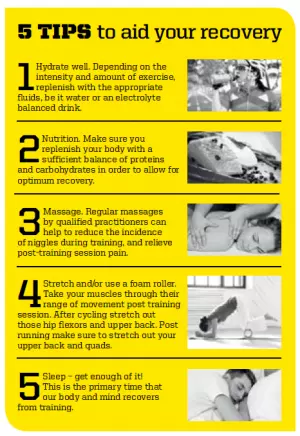
Training doesn’t make us fitter – recovery from training does. So, how do we recover? @TriRadar An easy jog or spin, or a lazy day on the sofa, asks Beate Stindt, chartered physiotherapist at Six Physio
​Recovery can be either active or passive. Passive recovery is just that; total rest. A passive recovery day should not include any training. On these days you should rest and recover, which means no spring cleaning and no walking around the shops for the whole day.
An active recovery session usually involves your usual sport, be it running, swimming, cycling or yoga, but at an easy to moderate intensity. Active recovery has been likened to a short nap – the aim is to feel better at the end of your workout than you did at the beginning.
Training for an event places a huge amount of stress on your body and hard sessions result in the hormone cortisol being released. Cortisol is a natural anti-inflammatory but, left to hang around in the blood for too long, can negatively interfere with muscle regeneration.
One aim of active recovery is to clear the metabolic waste resulting from exercise, as well as providing a higher level of blood flow to muscles in need of nutrients, allowing them to repair themselves.
While there is not yet conclusive evidence showing whether or not this really does result in quicker recovery, if you are going to try it, it’s important that it’s done correctly so as not to contribute to fatigue. Many athletes will use an active recovery session as a technical workout and focus on form and technique, something they might not be able to do during sessions with a higher intensity where technique work can be drowned out.
Some athletes will have a recovery workout in between two hard workouts while others may include a recovery week in their training programme. A general rule of thumb for a recovery week/session would be to reduce the volume of your training by approximately 30 per cent. If you train according to heart rate, make sure you complete your session at less than 60 per cent of your maximum heart rate. If you need a break from all technology, as a general rule you should make sure you can still continue a conversation. You should be able to speak in full sentences and not only the odd word or grunt. Another way to make sure that you are not working too hard is to make sure you are comfortable breathing through your nose (make sure all nasal passages are clear!).
So which is best? The jury is still out. Like so many things in training, everyone has their own personal preference and it is important to find your own and do it correctly. If you’re going to include active recovery sessions as a part of your training, resign yourself to the fact that you might not get admiring looks from passers by or that you might be overtaken by your elderly neighbour on her bicycle with a fully laden basket. But remember: that’s okay!
